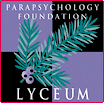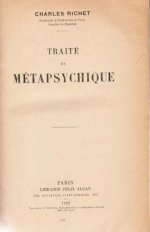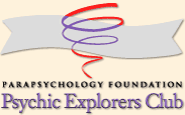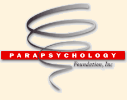 |
 |
| The Traité de métapsychique  In 1922 Richet presented to the French Academy of Sciences, his celebrated Traité de métapsychique. In his presentation, Richet said he was summarizing methodically many observations and tests conducted by men such as William Crookes and William James. In 1922 Richet presented to the French Academy of Sciences, his celebrated Traité de métapsychique. In his presentation, Richet said he was summarizing methodically many observations and tests conducted by men such as William Crookes and William James.
Richet hoped that the “irregular and singular facts” acertained by these and other men deserved deep study, in contrast to “sarcasms and silent disdain” (Mémoires et Communications, 1922, p. 429). The phenomena discussed, he carefully stated for his conservative audience, “are new; they are inhabitual; they are difficult to classify” (p. 430), but they did not contradict any scientific facts. This was the best known book Richet published on psychical research. It was translated into languages such as German, and Spanish. The English translation, entitled Thirty Years of Psychical Research (which can be downloaded as a text version by clicking this link), appeared in 1923, translated from the second French edition. The book was extremely influential in France, and in parts of Europe, commanding longer than usual reviews in specialized journals such as Luce e Ombra (Bozzano, 1922) and the Proceedings of the Society for Psychical Research (Lodge, 1923), in which Richet was both praised and criticized on several grounds. Richet’s book, a true treatise, summarized and referenced a myriad of spontaneous cases, experiments, and mediumistic studies. He grouped the mental, or subjective phenomena, under the term of crypthesthesia, by which he meant “a special and mysterious faculty which reveals certain facts, past, present, or future, that the senses are unable to supply” (Richet, 1923, p. 64). This included what other authored referred to as clairvoyance and telepathy. In contrast objective metapsychics included telekinesis and ectoplasms, which he conceptualized as “degrees of the same thing—the objectification or projection of an intelligent mechanical energy” (p. 489). He concluded the following:
The book’s table of content, taken from the English translation, gives a good idea of the topics discussed: BOOK I: CONCERNING METAPSYCHICS IN GENERAL Bozzano, E. (1922). Considerazioni intorno al “Traité de Métapsychique” del Prof. Charles Richet. Luce e Ombra, 22, 103–115. Lodge, O. (1923). A textbook of metapsychics: Review and critique. Proceedings of the Society for Psychical Research, 34, 70–106. Mémoires et communications des membres et des correspondants de l’Academie. Compte rendu hebdomadaires des séances de l’Académie des Sciences, 174, 430–431. Richet, C. (1922). Traité de métapsychique. Paris: Félix Alcan. Richet, C. (1923). Thirty Years of Psychical Research. New York: Macmillan. (Translated from the second French edition) |
 |

|
 www. parapsychology. org |
||